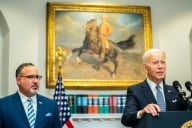You have /5 articles left.
Sign up for a free account or log in.
A professor asked me this week about the possible impact of the recent executive order “on Combating Race and Sex Stereotyping.” I’ll admit the question prompted me to read the thing.
As written, it’s … confused. But that’s the point.
As an academic administrator and a political scientist, I’m accustomed to translating one idiom to the other and back again. They speak in different dialects. As a painfully easy example, ask any card-carrying American political theorist to define “liberal.” (You might want to pull up a chair; you’ll be there a while.) “Liberal democracy” and “Liberal Democrats” are not the same thing by a country mile, but in common speech, they’re often confused. So it’s not inherently shocking that a piece written in one idiom -- in this case, the political one -- requires some translation before making sense in the other.
But this goes beyond word choice or prose style. It goes to basic coherence.
Look at the language in Section 1: “heroic Americans have valiantly risked their lives …” “This ideology is rooted in the pernicious and false belief …” Or my personal favorite: “this malign ideology is now migrating from the fringes of American society and threatens to infect core institutions of our country …” Words like “heroic” and “valiantly,” on one side, or “pernicious,” “malign,” “fringes” and “infect” on the other, are hardly value-neutral. To call them “loaded” would almost be understating. They tell a tale of clear and obvious good guys and bad guys, even relying on the classic image of infection to describe the bad ones. In this section, a clear moral preference is asserted without apology.
Ironically, the great sin ascribed to the bad guys is “divisiveness.”
Okay, so it lacks self-awareness. That’s not unusual. But how does it apply to higher education?
Section 10 provides the answer. “Nothing in this order shall be construed to prohibit discussing, as part of a larger course of academic instruction, the divisive concepts listed in section 2(a) of this order in an objective manner and without endorsement.”
Squaring “in an objective manner” with a “malign” ideology that “threatens to infect” requires a bit of suspension of disbelief. Are we supposed to be objective, or are we supposed to side with the good guys against the bad guys? And without investigating, just exactly how are we supposed to know a priori which side is which? Do we refer to the Civil War, the War Between the States or the War of Northern Aggression? Which is objective, and how do we know? And in this context, what does “endorsement” mean?
I can’t imagine trying to teach American history like this. If you teach that, say, racism was ended in the 1960s with the Civil Rights Act, then you will face some awkward moments in trying to explain voting patterns, current distributions of income and wealth by race, and why so many people are angry about police brutality. (I suppose even raising those questions would be considered “divisive.”) If a student looks at, say, Mount Rushmore, and asks why there aren’t any women on it -- which, objectively, there aren’t -- what do you say? If that same student goes on to ask why there has never been a woman president -- which, objectively, there has not been -- what do you say?
Of course, I’m taking the proposal much too literally. It’s an exercise in team sports; reading it as anything deeper than that is giving it far too much credit. It’s meant to intimidate those who raise uncomfortable questions, and confusion is an effective tactic for the strong to disempower the weak. Foucault noted years ago that the way the panopticon works is by sowing uncertainty among the prisoners about when they’re being watched; since they can’t know for sure, the theory goes, they start to watch themselves. That’s what this is. By being both obtuse and contradictory, it fails intentionally at its stated purpose of offering clear guidance. That’s the point. Clear guidance could be inadvertently empowering. By twisting loaded emotional terms into mind pretzels, it suggests danger without offering any safe haven other than obedience to the whims of the strong.
Movements for equality are not infections. Critiques of exploitation are not pernicious; they’re our best hope for improving life on the ground. By all means, teach the complexity of history, the clay feet of heroes and the flaws of otherwise admirable figures. If other flawed people can make history, then we can, too. That’s what’s really at stake here. So as educators, we have a basic choice to make. That’s the impact.







